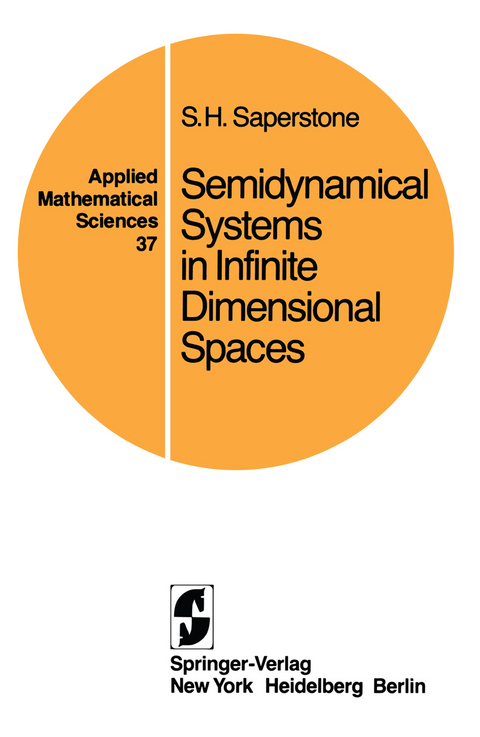
Semidynamical Systems in Infinite Dimensional Spaces
Springer-Verlag New York Inc.
978-0-387-90643-0 (ISBN)
Where do solutions go, and how do they behave en route? These are two of the major questions addressed by the qualita tive theory of differential equations. The purpose of this book is to answer these questions for certain classes of equa tions by recourse to the framework of semidynamical systems (or topological dynamics as it is sometimes called). This approach makes it possible to treat a seemingly broad range of equations from nonautonomous ordinary differential equa tions and partial differential equations to stochastic differ ential equations. The methods are not limited to the examples presented here, though. The basic idea is this: Embed some representation of the solutions of the equation (and perhaps the equation itself) in an appropriate function space. This space serves as the phase space for the semidynamical system. The phase map must be chosen so as to generate solutions to the equation from an initial value. In most instances it is necessary to provide a "weak" topology on the phase space. Typically the space is infinite dimensional. These considerations motivate the requirement to study semidynamical systems in non locally compact spaces. Our objective here is to present only those results needed for the kinds of applications one is likely to encounter in differen tial equations. Additional properties and extensions of ab stract semidynamical systems are left as exercises. The power of the semidynamical framework makes it possible to character- Preface ize the asymptotic behavior of the solutions of such a wide class of equations.
I. Basic Definitions and Properties.- 1. Introduction.- 2. Semidynamical Systems: Definitions and.- Conventions.- 3. A Glimpse of Things to Come; An Example from a Function Space.- 4. Solutions.- 5. Critical and Periodic Points.- 6. Classification of Positive Orbits.- 7. Discrete Semidynamical Systems.- 8. Local Semidynamical Systems; Reparametrization.- 9. Exercises.- 10. Notes and Comments.- II. Invariance, Limit Sets, and Stability.- 1. Introduction.- 2. Invariance.- 3. Limit Sets: The Generalized Invariance Principle.- 4. Minimality.- 5. Prolongations and Stability of Compact Sets.- 6. Attraction: Asymptotic Stability of Compact Sets.- 7. Continuity of the Hull and Limit Set Maps in Metric Spaces.- 8. Lyapunov Functions: The Invariance Principle.- 9. From Stability to Chaos: A Simple Example.- 10. Exercises.- 11. Notes and Comments.- III. Motions in Metric Space.- 1. Introduction.- 2. Lyapunov Stable Motions.- 3. Recurrent Motions.- 4. Almost Periodic Motions.- 5. Asymptotically Stable Motions.- 6. Periodic Solutions of an Ordinary Differential Equation.- 7. Exercises.- 8. Notes and Comments.- IV. Nonautonomous Ordinary Differential Equations.- 1. Introduction.- 2. Construction of the Skew Product Semidynamical System.- 3. Compactness of the Space ?.- 4. The Invariance Principle for Ordinary Differential Equations.- 5. Limiting Equations and Stability.- 6. Differential Equations without Uniqueness.- 7. Volterra Integral Equations.- 8. Exercises.- 9. Notes and Comments.- V. Semidynamical Systems in Banach Space.- 1. Introduction.- 2. Nonlinear Semigroups and Their Generators.- 3. The Generalized Domain for Accretive Operators.- 4. Precompactness of Positive Orbits.- 5. Solution of the Cauchy Problem.- 6. Structure of Positive Limit Sets for Contraction Semigroups.-7. Exercises.- 8. Appendix: Proofs of Theorems 2.4 and 2.16.- 9. Notes and Comments.- VI. Functional Differential Equations.- 1. Why Hereditary Dependence, Some Examples from Biology, Mechanics, and Electronics.- 2. Definitions and Notation: Functional Differential Equations with Finite or Infinite Delay. The Initial Function Space.- 3. Existence of Solutions of Retarded Functional Equations.- 4. Some Remarks on the Semidynamical System Defined by the Solution to an Autonomous Retarded Functional Differential Equation: The Invariance Principle and Stability.- 5. Some Examples of Stability of RFDE’s.- 6. Remarks on the Asymptotic Behavior of Nonautonomous Retarded Functional Differential Equations.- 7. Critical Points and Periodic Solutions of Autonomous Retarded Functional Differential Equations.- 8. Neutral Functional Differential Equations.- 9. A Flip-Flop Circuit Characterized by a NFDE — The Stability of Solutions.- 10. Exercises.- 11. Notes and Comments.- VII. Stochastic Dynamical Systems.- 1. Introduction.- 2. The Space of Probability Measures.- 3. Markov Transition Operators and the Semidynamical System.- 4. Properties of Positive Limit Sets.- 5. Critical Points for Markov Processes.- 6. Stochastic Differential Equations.- 7. The Invariance Principle for Markov Processes.- 8. Exercises.- 9. Notes and Comments.- VIII. Weak Semidynamical Systems and Processes.- 1. Introduction.- 2. Weak Semidynamical Systems.- 3. Compact Processes.- 4. Uniform Processes.- 5. Solutions of Nonautonomous Ordinary Differential Equations Revisited — A Compact Process.- 6. Solutions of a Wave Equation — A Uniform Process.- 7. Exercises.- 8. Notes and Comments.- Appendix A.- 0. Preliminaries.- 1. Commonly Used Symbols.- 2. Nets.- 3. Uniform Topologies.- 4. Compactness.- 5. LinearSpaces.- 6. Duality.- 7. Hilbert Spaces.- 8. Vector Valued Integration.- 9. Sobolev Spaces.- 10. Convexity.- 11. Fixed Point Theorems.- 12. Almost Periodicity.- 13. Differential Inequalities.- Appendix B.- 1. Probability Spaces and Random Variables.- 2. Expectation.- 3. Convergence of Random Variables.- 4. Stochastic Processes; Martingales and Markov Processes.- 5. The Ito Stochastic Integral.- References.- Index of Terms.- Index of Symbols.
| Reihe/Serie | Applied Mathematical Sciences ; 37 |
|---|---|
| Zusatzinfo | 492 p. |
| Verlagsort | New York, NY |
| Sprache | englisch |
| Maße | 155 x 235 mm |
| Themenwelt | Mathematik / Informatik ► Mathematik ► Analysis |
| Naturwissenschaften ► Physik / Astronomie ► Allgemeines / Lexika | |
| Naturwissenschaften ► Physik / Astronomie ► Theoretische Physik | |
| ISBN-10 | 0-387-90643-6 / 0387906436 |
| ISBN-13 | 978-0-387-90643-0 / 9780387906430 |
| Zustand | Neuware |
| Haben Sie eine Frage zum Produkt? |
aus dem Bereich


